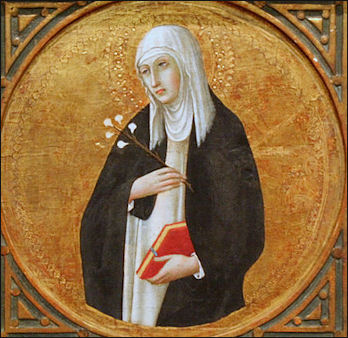April
29 is the feast day of the woman I consider the patron saint of this blog, St. Catherine of Siena. Ever since I read her biography during the first year of this blog, I fell in
love with the little woman. I’ve spent a
lot time expanding getting to know more about her life, her writings, and her
theology. Why would a literature blog
pick St. Catherine of Siena as its patron?
Well, she is a Doctor of the Church, which means her writings have contributed in some way to church teaching. But it’s not just that. After all I could have picked St. Francis De Sales, who is also a Doctor and the patron saint of writers. But I read St. Catherine first and fell in
love with her writing, even if I don’t always understand it. What makes Catherine’s writing special to me
is that she always seems to think in imagery, and finds the most perceptive
image. She is a natural born poet. It’s amazing to me she had no education and
learned to write as an adult.
For
example, take this passage from Prayer #11, translated by St. Catherine of
Siena scholar, Suzanne Noffke, OP:
Today your Truth, with
wonderful light,
points out the source of
darkness,
that stinking garment,
the selfish will.
And your Truth reveals as
well
the means by which we
come to know the light,
the garment of your
gentle will.
What a marvelous thing,
that even while we are in
the dark
we should know the light!
that in finite things
we should know the
infinite!
that even while we exist
in death
we should know life!
Your Truth shows us
that the soul must strip
herself of her selfish will
if she wants to be
clothed perfectly in yours,
just as one turns one’s
garment inside out
when one undresses.
Quote
is taken from The Prayers of Catherine of
Siena, 2nd Edition, Suzanne Nofke, OP, Translator and Editor,
Paulist Press, 1983.
If
you didn’t catch the metaphor, she uses clothing as a metaphor for two
different wills, God’s will and the “stinking” selfish will, and she ups the
ante of the metaphor by giving us the image of undressing and turning the
garment inside out when we strive to put on God’s garment. She seems to express everything in imagery.
You
may have also noticed on my blog I fixed one of Catherine’s quotes: "Love
follows knowledge." This comes from
her a book titled, Little Talks with God,
which is an organized condensation of Catherine’s Dialogue, her great work and easier to read if you want to explore her writing.
When the soul is lifted
by a great, yearning desire for the honor of God and the salvation of souls, it
practices the ordinary virtues and remains in the cell of self-knowledge, so
that it may know better God’s goodness toward it. It does this because knowledge must come
before love, and only when it has attained love can it strive to follow and to
clothe itself with the truth.
But humble and continuous
prayer, founded on knowledge of oneself and of God, is the best way for the
creature to receive such a taste of the truth.
Following the footprints of Christ crucified, and through humble and
unceasing prayer, the soul is united with God.
He remakes it in his image through desire, affection, and the union of
love.
There’s
a lot to unpack there, but it hinges on Catherine’s term, “the cell of
self-knowledge” and what I think she means by it is that one must have and nurture
a personal relationship with God before one can obtain the knowledge of God,
and then can one love, not just God but all of humanity. Now that’s what I think she’s saying. But she’s light years above my little brain.
You
can click on the Catherine of Siena tag and find several of my posts on her
and her work.


Happy feast day, Manny!
ReplyDeleteHappy feast day and thank you.
ReplyDeleteGod bless.
Thank you guys.
ReplyDelete